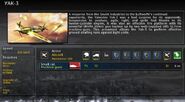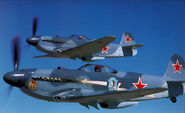The upgrade of the Ishak fighter, the Yakovlev Як-3 is a blessing for Russian commanders, who can finally deploy a capable fighter to stand up to enemy air raids. Even with the Yak, however, Russia is still far behind in its air-force, as a standard ME109 or Zero can match the Yak-3 in any dogfight. Make sure to deploy these fighters in high numbers to cover your ground attacks.
History
For the Soviets, the P47 Thunderbolt was a pushover. There were no heavy bombers to gun down, and the Sturmovik was the big gun. Armaments were by far a lower priority than agility, and Yak-3 is a proud example. Carrying a 20mm autocannon and a pair of 12.7mm machine guns, sometimes supplemented by rockets, the craft was light, and thus a fast climber. When supplemented by Lavochkin and Mikoyan and Gurevich (yes, early MiGs, namely MiG-3), as well as an occasional lend-lease Hurricane or a P-39 Aerocobra and crewed by the battle-tested Soviet aces, the Soviet Air Force becomes a far more impressive adversary. It even claimed at least five USAAF kills due to the "friendly fire" incidents on behalf of Americans.
The Yak-3 in particular was built in 1943 on the base of Yak-1, an underarmed but equally agile dogfighter. It remained in service until the very end of the war, despite the appearance of newer yet similar Yak-7s and Yak-9s. It's safe to say underarmament was the VVS RKKA's policy.
Weapons
| Weapon | ||||||||||
|---|---|---|---|---|---|---|---|---|---|---|
Small cal. Machine-guns |
75 | 75 | 31 | 0m |
Gallery
See Also
| ||||||||||||||||||||||||||


